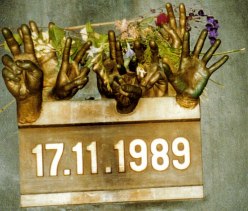Socialist Czechoslovakia
As the dust settled on the Second World War, the Red Army that had liberated Prague wasn’t budging – the Czechs had voted in a Communist government, and started down the Central-Eastern European path to socialism alongside other Warsaw Pact nations.
The long list of progressive social reforms that greatly benefitted the Czech and Slovak working-classes – guaranteed jobs, social security, state-provided healthcare and education for all – were heavily offset by Cold War paranoia. Under Stalin, the Soviet dominion became ever more repressive.
Prague Spring
Twenty years later, increasingly free-thinking and rebellious even after two decades of Stalinist oppression, the Czech people again caught global attention by trying to liberalise and democratise the repressive Soviet model under maverick Slovak Communist Alexander Dubcek.
Dubcek’s “Socialism with a Human Face” was short-lived, however – his reforms, and the popular movement that had materialised around them, was looked upon as a dangerous counter-revolution by Soviet authorities.
Soviet and Warsaw Pact tanks were dispatched to stamp out Prague’s youthful Spring and bring back the Stalinist deep-freeze. The move did, however, bring another nail in the coffin of Stalin’s legacy – Western Communist parties recoiled at the brutality of the Soviet intervention, watching Czech students and workers grappling with Red Army tanks with their bare hands. This wasn’t the ‘fascist counter-revolution’ that Soviet propaganda tried to present Prague’s Spring as. Instead it was a genuine explosion of anger and bewilderment, as a country tried to achieve its own distinctive brand of socialism, but was prevented by an occupying power that saw any deviation from the Stalinist model as dangerously subversive.
In January 1969, Czech student Jan Palach set fire to himself in Prague’s Wenceslaus Square in protest at the Soviet intervention. He died of his injuries. The Czech Communists responded by imposing a period of ‘Normalisation’ which lasted through the 1970s and into the 80s and sought to return Czechoslovakia to the Soviet-approved form of authoritarian socialism.
The Velvet Revolution
Having held sway across much of Central and Eastern Europe for nearly fifty years, the Communist bloc finally came tumbling down in the late ’80s.
In November 1989, a month after the fall of the Berlin wall, it was Czechoslovakia’s turn. After years of Communist repression and popular resistance by Charter 77, the emergence of the reforming Soviet leader Mikhail Gorbachev gave the green light to Czech anti-communist aspirations.
On November 17, a demonstration in Prague, organised by the Czech Young Socialists, was attacked by the Police in Narodni street. A KGB man – working on Gorbachev’s orders – pretended to be killed by the Police and the rumour became widespread around Prague. The next day demonstrations in Wenceslaus Square quadrupled and the Communist old-guard threw in the towel.
This so called ‘Velvet Revolution’ was bloodless, and Czechoslovakia again called itself a Western-style parliamentary democracy, electing playwright and dissident Vaclav Havel to the Presidency.

Bridgwater Czech Twinning
Bridgwater Czech Slovak Friendship Society
Bridgwater became the first British town to formally twin with a Czech town after the Velvet Revolution.
During the 1980s, a series of social history plays about Bridgwater had been written by Brian Smedley and performed by the Sheep Worrying Theatre Group at Bridgwater’s Historic Arts Centre. One of the first was about Vernon Bartlett, appeasement, and the Bridgwater by-election of 1938.
Smedley visited Communist Czechoslovakia in 1986 and wrote a play and book about the Bridgwater link. After the Velvet Revolution in 1989, he responded to a request from a Czech socialist Antonin Machala, from Uherske Hradiste, to visit again. The result was the establishment of the Bridgwater Czechoslovakia Friendship Society which campaigned for, and eventually acheived, a formal twinning between the two towns.
The Twinning Document and Oath of Friendship was signed on June 18 1992 – completely coincedentally, fifty years to the day after the battle in the crypt at Resslova in Prague at which the Czech and Slovak paratroopers who had assassinated Heydrich, Hitler’s man in Prague, made their courageous last stand.
The above picture shows the first visit by Antonin to Bridgwater in 1991 – received by Mayor of Bridgwater Cllr Ken Richards. Also in the photo are Cllr Smedley and Cllr Mac McCausland, who became Secretary and Treasurer respectively of the newly formed Friendship Society.
The Bridgwater-Czechoslovakia Friendship Society changed its name to the Bridgwater-Czech/Slovak Friendship Society in 1993 – Czechoslovakia had split in the so-called ‘Velvet Divorce’ and formed two separate republics – and has existed ever since, organising exchange projects involving schools, choirs, football teams, hobby groups, civic parties, trades unionists and others.
Brian Smedley has been a Sedgemoor District Councillor since 1990 and remains the secretary of the Friendship Society.
Antonin Machala was an aircraft engineer at Let Kunovice Works in 1989, and today runs his own stairlift and wheelchair ramp business, Altech sro, employing 150 workers in Uherske Hradiste.
Each year both friends (now both in their 50s) take workers’ football teams to different East European Countries to spread the message of international friendship.
For more information see www.bridgwaterinternational.co.uk



